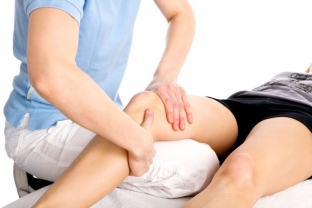Pain in the knee joint makes people of any age go to the doctor, regardless of the lifestyle. Causes of pain range from minor injuries to serious illnesses. As a rule, in a healthy person, mobility is not accompanied by painful sensations – they occur as a result of daily wear and tear, overuse or injury.
However, discomfort and stiffness of movement may occur during sports, recreation, work tasks or homework. estet-portal.com will tell you in which cases the pain can be relieved on your own, and in which it is necessary to consult a doctor.
General classification of causes of knee pain
One of the largest joints in the body is the knee joint. The upper (femur) and lower (tibia and fibula) bones that form the joint are separated by two discs (menisci) and connected by ligaments, tendons and muscles. The surface of the bones in the joint is covered with articular cartilage, which absorbs shock and provides a smooth surface for proper joint mobility. Synovial fluid, and it is she who acts as a joint lubricant, is secreted in the joint bag, which is called the bursa.
Pain in the knee joint occurs for reasons that fall into three main categories:
• injuries: bone fractures, torn ligaments or meniscus;
• diseases: inflammatory, infectious;
• diseases resulting from chronic overexertion: bursitis (read more about symptoms and treatment at artrozamnet.ru), osteoarthritis, tendinitis.
Injuries, overwork and diseases – main triggers for knee pain.
Pain in the knee joint: a list and description of the most common causes
The list of causes contributing to the appearance of pain in the knee joint is given below.
1. Arthritis (and its varieties). Age, excess weight, frequent physical activity and weakening of the immune system – factors contributing to the development of arthritis. Redness and swelling, local temperature increase, pain and stiffness of movements – the main symptoms of the disease.
2. Tendinitis. This name is used to refer to inflammation of the tendons of the joint.
Tendinitis most often worries:
• athletes,
• children;
• elderly people.
Injuries, uncomfortable shoes, constant stress, weakened muscles, muscle imbalance, other inflammatory diseases, weakened immunity contribute to the development of tendonitis. There is swelling in the knee area and limited mobility, with movement there is often a characteristic creaking.
3. Bursitis. Inflammation of the articular bag does not limit the patient's ability to bend / unbend the leg at the knee joint (this feature distinguishes bursitis from arthritis). However, pain when walking, pressing, at rest, which are local in nature, as well as swelling. An increase in temperature can be observed in a limited area (in the area of \u200b\u200bthe bursa itself) or throughout the body.
4. Gout. It is manifested by reddening of the skin over the affected joint and sharp bouts of pain. Since the accumulation of uric acid characterizes this pathology, the cause of its appearance is a violation of urinary metabolism.
5. Injuries. Violation of the integrity of the bones, menisci, ligaments and tendons that enter the knee joint occurs due to mechanical action.
Damage to one of the components of the knee joint can be caused by:
• blows;
• falls;
• careless movements;
• jerky movements.
Only a specialist can accurately determine the root cause of knee pain.
Other diseases that can lead to pain in the knee:
• Osgood-Schlatter disease;
• Koening's disease;
• Baker's cyst;
• osteomyelitis;
• fibromyalgia;
• Pezhdet's disease;
• gonarthrosis;
• Lyme disease;
• Reiter's syndrome.
When does knee pain require medical attention

In addition to the diseases described above, pain in the knee joint can be provoked by banal overwork, unusually strong or prolonged loads. In such cases, as a rule, pain and discomfort after rest disappear spontaneously, without any intervention.
• pain arose sharply after inaccurate movement; • the onset of pain was preceded by a strong blow or fall;
• swelling is visible in the knee area;
• the pain is too strong;
• the pain does not go away after rest (maximum after a couple of days);
• the leg at the knee does not bend;
• walking is impossible or very painful;
• in the joint area there is deformation, the presence of a painful lump;
• the temperature of the joint (or the whole body) is increased;
• redness is observed on the entire knee or its individual parts.
Based on the opinion of experts, estet-portal.com urges not to ignore long-term, persistent or regular pain in the knee joints, especially if they are accompanied by other symptoms. Remember that the exact cause of pain can only be determined after an examination by an experienced doctor (if necessary, using special equipment and tests).






Add a comment